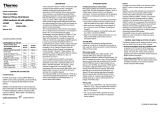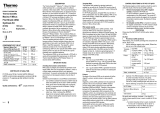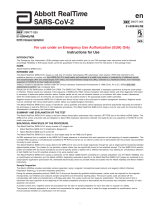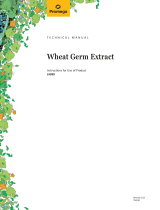Page is loading ...

PRODUCT INFORMATION
Thermo Scientific
Maxima™ H Minus cDNA Synthesis
Master Mix with dsDNase
Pub. No. MAN0016393
Rev. Date 9 January 2017 (Rev. B.0)
Kit contents
Component
#M1669
(10 rxns)
#M1681
(50 rxns)
#M1682
(200 rxns)
Maxima H Minus cDNA
Synthesis Master Mix (5X) 40 µL 200 µL 800 µL
Maxima No RT Control
40 µL
200 µL
200 µL
dsDNase
10 µL
50 µL
200 µL
10X dsDNase Buffer
20 µL
100 µL
400 µL
Water, nuclease-free
1.25 mL
1.25 mL
1.25 mL
Store at –20°C
www.thermofisher.com
For Research Use Only. Not for use in diagnostic procedures.
DESCRIPTION
The Thermo Scientific™ Maxima™ H Minus cDNA Synthesis
Master Mix with dsDNase provides a simple workflow that
combines genomic DNA elimination and cDNA synthesis in a
one-tube procedure. The system is convenient, and
optimized for cDNA synthesis in two-step real time
quantitativ e RT-PCR (RT-qPCR) applications.
The kit contains a double-strand specific DNase (dsDNase)
engineered to remove contaminating genomic DNA from
RNA samples in 2 minutes without affecting quality or
quantity of RNA. Highly specific dsDNase activity towards
double-stranded DNA ensures that RNA and single-stranded
DNA (such as cDNA and primers) are not cleaved and
allows dsDNase treated RNA to be directly added to reverse
transcription reactions.
The master mix contains Maxima H Minus Reverse
Transcriptase (RT) and Thermo Scientific™ RiboLock™
RNase Inhibitor. Maxima H Minus Reverse Transcriptase is
an advanced enzyme derived from M-MuLV RT. The
enzyme features high thermostability, robustness, and
increased cDNA synthesis rate compared to wild ty pe
M-MuLV RT. The recombinant RiboLock RNase Inhibitor
effectively protects RNA template from degradation by
RNases A, B, and C at temperatures up to 55°C. The master
mix also contains reaction buffer, dNTPs, oligo (dT)18, and
random hexamer primers.
The Maxima H Minus cDNA Synthesis Master Mix is capable
of reproducible cDNA synthesis starting with 1 pg to 5 µg of
total RNA at elevated temperatures (50–65°C). The
synthesis reaction can be completed in 15–30 minutes.
PROCEDURAL GUIDELINES
Avoiding ribonuclease contamination
RNA purity and integrity is essential for synthesis of full-
length cDNA. RNA can be degraded by RNase A, which is a
highly stable contaminant found in laboratory environments.
General recommendations to avoid RNase contamination:
•Use certified nuclease-free labware or DEPC-treat all
tubes and pipette tips to be used in cDNA synthesis.
•Wear glov es when handling RNA and reagents, as skin is
a common source of RNases. Change gloves frequently.
•Use RNase-free reagents, including high quality water
(e.g., Water, nuclease-free, #R0581).
•Keep the kit components tightly sealed when not in use.
Keep all tubes tightly closed during the reverse
transcription reaction.
Template RNA
The kit is compatible with total cellular RNA isolated by
standard methods. Purified RNA must be free of salts, metal
ions, ethanol, and phenol to avoid inhibiting the cDNA
synthesis reaction.
Always perform a No RT Control reaction, which includes all
components for rev erse transcription except the Maxima H
Minus RT.
RNA sample quality
Assess RNA integrity prior to cDNA synthesis. Total
eukaryotic RNA can be analyzed by agarose gel
electrophoresis followed by ethidium bromide staining.
The RNA is considered intact, if both 18S and 28S rRNA
appear as sharp bands after electrophoresis of total RNA.
The 28S rRNA band should be approximately twice as
intense as the 18S rRNA. Smearing of rRNA bands is an
indication of degraded mRNA, and a new sample of total
RNA should be prepared.
Alternatively, total RNA can be analyzed using a bioanalyzer
(e.g., Agilent 2100) to obtain a RNA integrity number, which
provides quantitative information about the general state of
the RNA sample (2). A reference gene/target gene
3’:5’ integrity assay (3) can also be used to determine the
integrity of the RNA sample.
Primers
The Maxima H Minus cDNA Synthesis Master Mix contains
oligo(dT)18 and random hexamer primers to prime synthesis
of first strand cDNA. This primer mixture ensures high
sensitivity in low copy number transcript detection assays.
PROTOCOL
Allow kit components to thaw, then mix and briefly
centrifuge. Store the tubes on ice.
1. Add the following reagents into a sterile, RNase free tube
on ice in the following order:
10X dsDNase Buffer
1 µL
dsDNase
1 µL
Template RNA
•Total RNA or
•poly(A) mRNA or
•Specific RNA
1 pg to 5 µg
0.1 pg to 500 ng
0.01 pg to 500 ng
Water, nuclease-free
to 10 µL
Total volume
10 µL
2. Mix gently and centrifuge.
3.
Incubate at 37°C in a preheated thermomixer or water
bath for 2 minutes.
4.
Chill on ice, briefly centrifuge and place on ice.
5. Add the following components to the tube on ice:
Maxima cDNA H Minus Synthesis Master
Mix (5X) 4 µL
Water, nuclease-free
6 µL
6. Mix gently and centrifuge.
7. Incubate at 25°C for 10 minutes.
8. Incubate at 50°C for 15 minutes.
Note. If using >1 µg RNA template, increase the reaction
time to 30 minutes. For RNA templates that are GC-rich or
have a large amount of secondary structure, the reaction
temperature can be increased to 65°C.
9. Terminate the reaction by heating at 85°C for 5 minutes.
The reaction product of the first strand cDNA sy nthesis can
be used directly in qPCR. Store at –20°C for up to one w eek,
or –70°C for long term storage. Av oid freeze-thaw cycles of
the cDNA.
qPCR
Use the product of the cDNA sy nthesis reaction directly in
qPCR. Normally, 2 µL of the RT product is used as template
for subsequent qPCR in a 25 µL total volume.
CONTROL REACTIONS
Use the follow ing negative control reactions to verify the
results of the first strand cDNA synthesis.
•No RT control to assess genomic DNA contamination of
the RNA sample. The Maxima No RT Control reaction
includes all reagents for the reverse transcription reaction
except the Maxima H Minus RT.
•No tem plate control (NTC) to assess for reagent
contamination. The NTC reaction includes all reagents
necessary for the reverse transcription reaction except the
RNA template.
(continued on reverse page)

Prepare control reactions according to the following
instructions.
Note: Template RNA amount and reverse transcription
incubation conditions should reflect the conditions used for
experimental samples.
1. Add the following reagents into a sterile, RNase free tube
on ice in the following order:
Component
No RT
control
No template
control
Maxima H Minus cDNA
Synthesis Master Mix (5X) — 4 µL
Template RNA
varies
—
Water, nuclease-free
to 20 µL
to 20 µL
Total volume
20 µL
20 µL
2. Mix gently and centrifuge.
3. Incubate at 25°C for 10 minutes.
4. Incubate at 50°C for 15 minutes.
5. Terminate the reaction by heating at 85°C for 5 minutes.
TROUBLESHOOTING
No qPCR product generated or product appears late
in qPCR
Poor integrity of RNA template
RNA purity and integrity is essential for synthesis and
quantification of cDNA.
• Always assess the integrity of RNA prior to cDNA
synthesis.
• Use freshly prepared RNA.
• Multiple freeze/thaw cycles of the RNA sample and
synthesized cDNA is not recommended.
• Follow general recommendations to av oid RNase
contamination and discard low quality RNA.
Low template purity (inhibitors in RNA sample)
Trace amounts of agents used in RNA purification
protocols may remain in solution and inhibit first strand
synthesis (e.g., SDS, EDTA, guanidine salts, phosphate,
pyrophosphate, polyamines, spermidine).
Remove trace contaminants by re-precipitating the RNA
with ethanol and w ash the pellet with 75% ethanol.
Insufficient template quantity
Increase the amount of RNA template in the first strand
reaction to the recommended level.
GC-rich template
If the RNA template is GC-rich or is known to contain
secondary structures, the temperature of the rev erse
transcription reaction can be increased up to 65°C.
Excess amount of cDNA in qPCR
Decrease amount of cDNA synthesis reaction in qPCR.
The volume of the cDNA synthesis reaction mixture
should not ex ceed 10% of the final PCR reaction mixture.
RT-qPCR product in No RT Control
RNA template is contaminated with DNA.
The presence of a PCR product in the negativ e control
(No RT Control) reaction indicates that the reaction is
contaminated with DNA. Follow the protocol carefully and
make sure that dsDNase treatment step prior reverse
transcription is not omitted. To further enhance genomic
DNA elimination efficiency, template RNA incubation with
dsDNase step can be prolonged to 5 minutes.
References
1. Wiame, I., et al., Irreversible heat inactivation of DNaseI
without RNA degradation, BioTechniques, 29, 252-256,
2000.
2. Fleige, S., Pfaffl, M.W., RNA integrity and the effect on the
real-time qRT-PCR performance, Mol. Aspects Med., 27,
126-139, 2006.
3. Nolan, T., et al., Quantification of mRNA using real-time
RT-PCR, Nat. Protoc., 1, 1559-1582, 2006.
IMPORTANT LICENSING INFORMATION
These products may be covered by one or more Limited Use Label
Licenses. By use of these products, you accept the terms and conditions
of all applicable Limited Use Label Licenses.
PRODUCT USE LIMITATION
This product is developed, designed and sold exclusively for research
purposes and in vitro use only. The product was not tested for use in
diagnostics or for drug development, nor is it suitable for administration to
humans or animals.
Refer to www.ther mofisher.com/support for the Safety Data Sheets.
© 2017 Thermo Fisher Scientific Inc. All rights reserved. All trademarks
are the property of Thermo Fisher Scientific and its subsidiaries unless
otherwise specified.
/















